How to Spot the Different Varieties of Conures
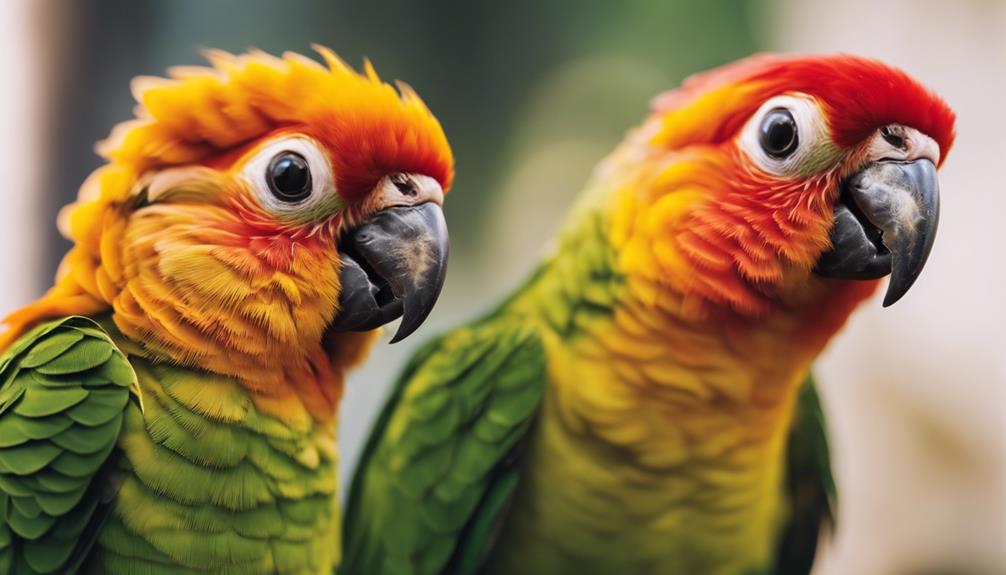
To identify the various types of conures, start by examining their vivid plumage colors, such as the bright green of the green-cheeked conure or the striking red of the sun conure. Additionally, note any distinctive markings, like the white eye rings of the maroon-bellied conure or the blue crown of the blue-crowned conure. Finally, listen for their vocalizations, which can range from high-pitched chirps to loud squawks, with each species having its own unique call. By combining these visual and auditory cues, you can confidently differentiate between different conure species.
Understanding these key characteristics will allow you to appreciate the diversity within the conure family and deepen your connection with these charismatic and colorful birds.
Sun Conures
Sun Conures, with their vibrant plumage and playful demeanor, are a popular choice among bird enthusiasts for their striking appearance and engaging personalities. These birds are known for their vibrant personalities and social tendencies, often seeking interaction and companionship. When it comes to care requirements, Sun Conures have unique needs that require attention. Their diet preferences include a variety of fruits, vegetables, and high-quality pellets to ensure they receive essential nutrients and maintain their colorful feathers.
Owners of Sun Conures must provide ample social interaction and mental stimulation to keep these intelligent birds happy and healthy. They thrive in environments where they can engage in play and exercise. Additionally, regular vet check-ups are crucial to monitor their health and well-being. Understanding the specific care requirements and diet preferences of Sun Conures is essential for anyone looking to welcome these charming birds into their homes.
Green-Cheeked Conures
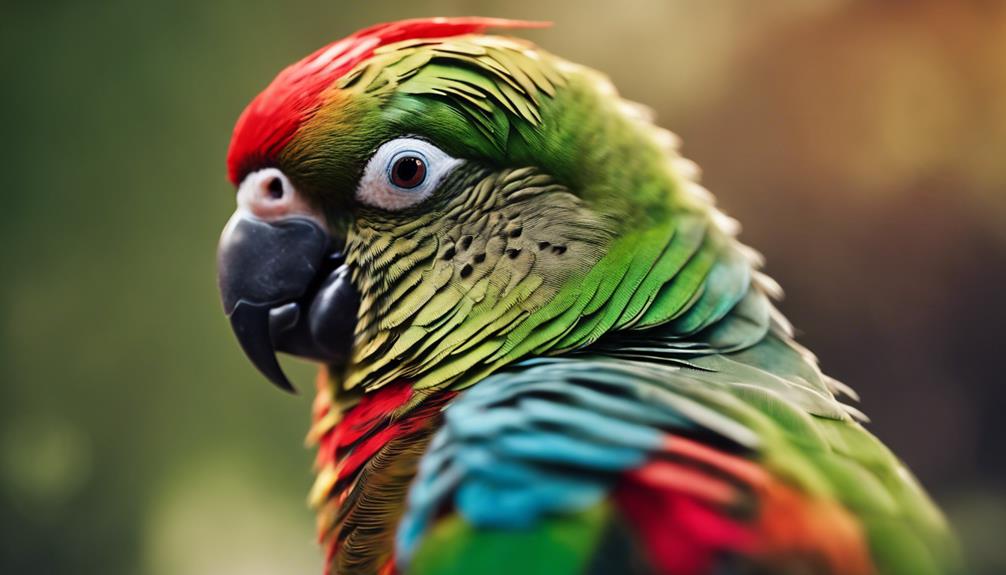
Green-Cheeked Conures are known for their colorful feather patterns, featuring vibrant shades of green, red, and blue.
These playful and social birds thrive on interaction and enjoy being part of a flock.
Green-Cheeked Conures typically fall within the small to medium-sized range, making them a popular choice for bird enthusiasts looking for a charming and manageable pet.
Colorful Feather Patterns
With vibrant shades of red, blue, and yellow interwoven in intricate patterns, the feather display of Green-Cheeked Conures is a sight to behold.
Their feathers often feature a striking combination of colors, ranging from deep crimson on the head and cheeks to emerald green on the body, complemented by splashes of blue and yellow on the wings.
These color patterns not only serve as a visual delight but also play a crucial role in their socialization and behavior.
The vibrant hues help Green-Cheeked Conures attract mates, communicate with other birds, and blend into their natural habitat.
Observing these colorful feather patterns can offer valuable insights into the unique characteristics and interactions of these charming birds.
Playful and Social
The sociable nature of Green-Cheeked Conures shines through in their playful interactions with both their avian companions and human caregivers. These vibrant birds thrive in an enriching environment that provides ample opportunities for behavioral enrichment. Bonding activities such as gentle head scratches and interactive play sessions are crucial for strengthening the bond between Green-Cheeked Conures and their human family members. Social interactions with other birds of similar temperament can also greatly benefit their overall well-being. Observing these playful creatures engage in joyful antics and chirpy conversations can bring warmth and joy to anyone's heart.
Providing engaging toys and puzzles for mental stimulation
Sharing mealtime with the conure for a sense of togetherness
Allowing supervised flying time outside the cage for physical exercise
Small to Medium-Sized
Playfully engaging in various activities, small to medium-sized Green-Cheeked Conures exhibit a delightful energy and charm that captivates those around them. These conures have vibrant plumage in shades of green, red, blue, and yellow, with a distinct red patch on their cheeks.
When it comes to breeding habits, Green-Cheeked Conures are known to be monogamous and form strong pair bonds. In terms of diet preferences, they enjoy a variety of fruits, vegetables, seeds, and pellets. Providing a spacious cage with plenty of toys and perches is essential for their well-being.
These conures thrive in environments with moderate temperatures, around 70-80°F (21-27°C), and moderate humidity levels. Green-Cheeked Conures aren't only visually striking but also make wonderful companions with their playful and affectionate nature.
Blue-Crowned Conures
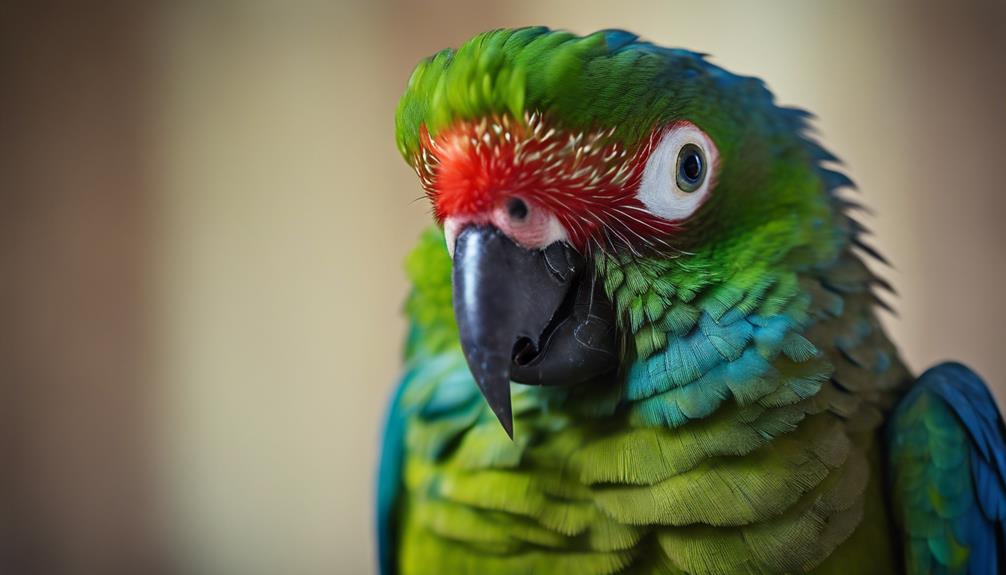
Blue-Crowned Conures boast vibrant plumage that sets them apart from other conure species. These birds aren't only visually striking but also exhibit unique behaviors that make them fascinating companions for bird enthusiasts. When it comes to caring for Blue-Crowned Conures, understanding their diet requirements is crucial for their well-being. Here are some key points to consider:
- Playful Personalities: Blue-Crowned Conures are known for their playful nature, often engaging in entertaining antics that can bring joy to those around them.
- Social Creatures: These conures thrive on social interaction and enjoy spending time with their human companions, forming strong bonds through shared activities.
- Vocal Communicators: Blue-Crowned Conures are expressive birds that use a variety of sounds to communicate their needs and emotions, making them engaging pets to interact with.
Jenday Conures
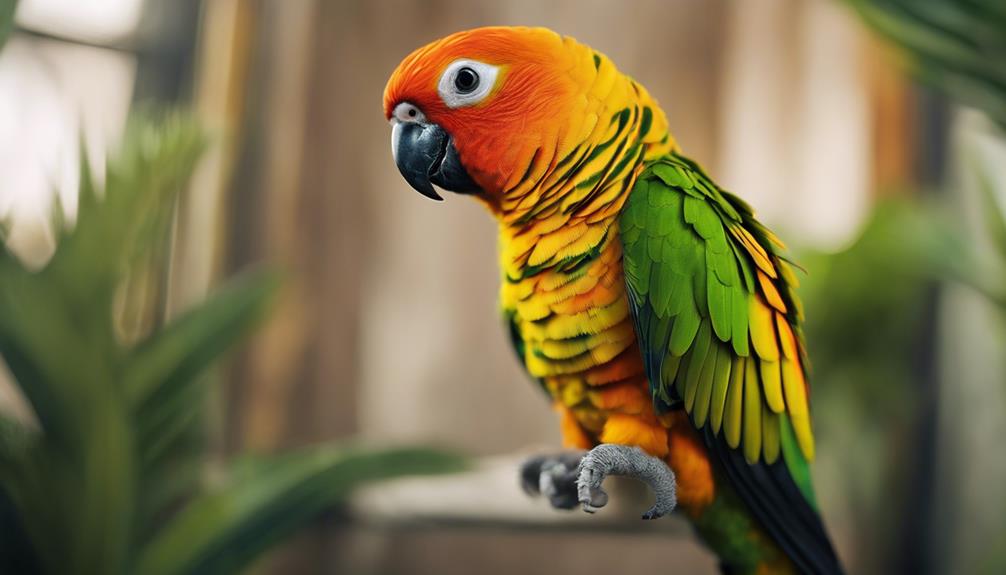
Jenday Conures are known for their vibrant plumage, with a striking mix of yellow, orange, and green feathers that make them stand out.
These birds are also recognized for their distinctive vocalizations, emitting loud, high-pitched calls that can be heard from a distance.
When spotting a Jenday Conure, their colorful appearance and unique sounds are key characteristics to look out for.
Colorful Plumage Features
Vibrant shades of yellow, red, and green intermingle to create the striking plumage of the Jenday Conure, making it a visually captivating bird species. The feather coloration of the Jenday Conure is a stunning mix of bright hues, with each feather displaying a unique blend of colors. Their plumage patterns are intricate and eye-catching, showcasing a beautiful mosaic of colors that stand out in any setting. When it comes to breeding habits, Jenday Conures are known for their vibrant displays during courtship rituals, where their colorful plumage plays a significant role. Observing these birds in their natural habitat, one can't help but be amazed by the breathtaking beauty of their colorful feathers.
- Vibrant hues: A mesmerizing mix of yellow, red, and green feathers.
- Intricate patterns: Complex plumage designs that captivate the eye.
- Breeding displays: Colorful plumage used in elaborate courtship rituals.
Distinctive Vocalizations
The captivating visual display of the Jenday Conure's colorful plumage is complemented by its distinctive vocalizations, which serve as a unique feature of this bird species.
Jenday Conures are known for their ability to mimic sounds, making them entertaining companions. Their vocal communication extends beyond mimicking, including distinct mating calls that play a crucial role in their flock behavior.
When observing Jenday Conures, one can appreciate the variety and complexity of their vocalizations, reflecting their social nature and strong bonds within their groups.
Whether mimicking household sounds or engaging in intricate mating calls, these vocalizations provide insight into the rich communication system of Jenday Conures, enhancing the overall experience of interacting with these colorful birds.
Nanday Conures
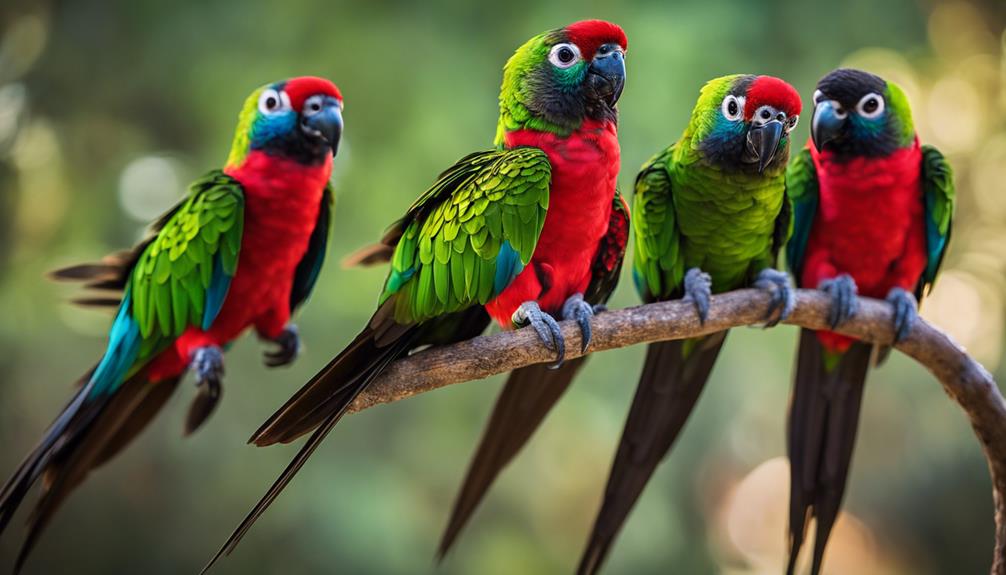
One distinctive feature of Nanday Conures is their striking black facial mask that contrasts with their vibrant green body. These playful birds are known for their energetic nature and sociable personalities, making them a delightful addition to any bird lover's home.
Nanday conures exhibit unique behaviors such as their love for interactive play and their tendency to form strong bonds with their human companions. When it comes to diet preferences, these birds enjoy a varied menu consisting of fresh fruits, vegetables, high-quality pellets, and the occasional treat. Providing a balanced diet is essential for their health and well-being.
Pineapple Conures
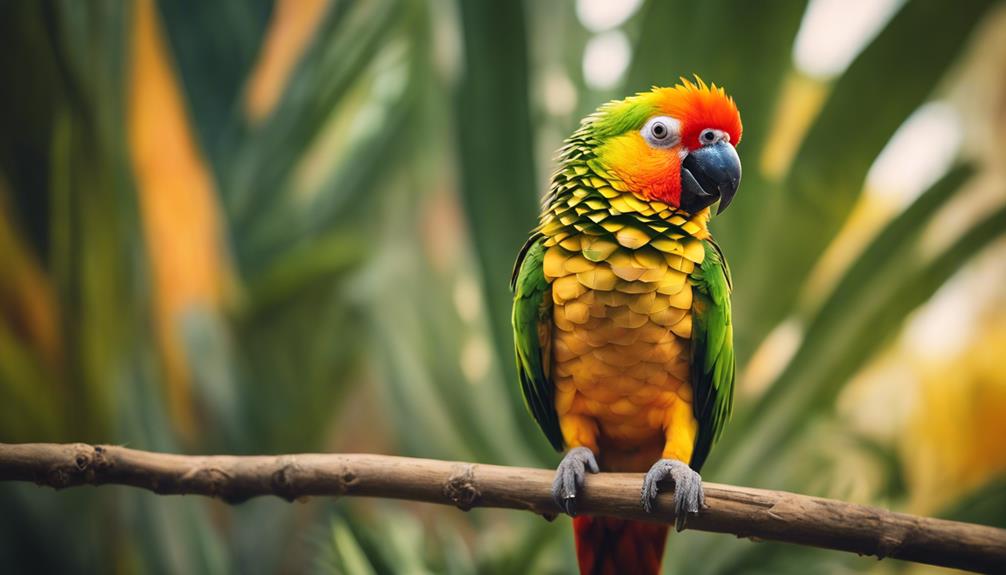
Exhibiting a distinctive blend of colors, Pineapple Conures showcase vibrant yellow and green hues that create a visually captivating appearance. These charming birds are known for their playful and affectionate nature, making them popular among bird enthusiasts. When it comes to breeding behavior, Pineapple Conures are monogamous and form strong bonds with their mates. In terms of diet, they require a balanced mix of high-quality pellets, fresh fruits, and vegetables to thrive.
| Aspect | Description |
|---|---|
| *Color* | Yellow and green with splashes of orange on the face and blue on the wings |
| *Size* | Approximately 10 to 12 inches in length |
| *Lifespan* | Around 20 to 30 years in captivity |
| *Care Requirements* | Regular social interaction, spacious cage, varied diet, and mental stimulation |
To ensure the well-being of Pineapple Conures, providing ample socialization, a spacious cage, and mental stimulation are essential. Their lifespan can range from 20 to 30 years, highlighting the commitment required when deciding to care for these delightful birds.
Dusky Conures
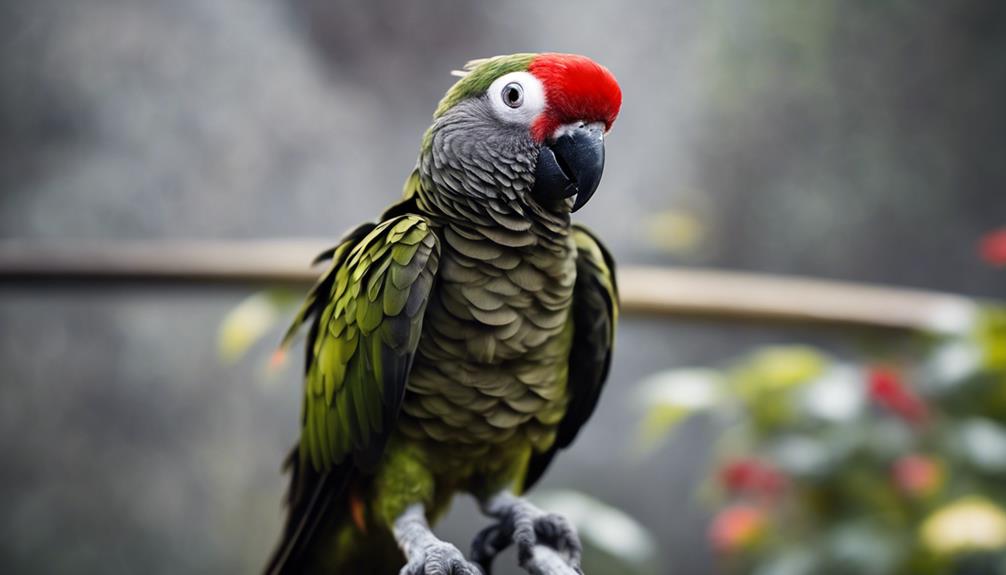
Displaying a subtle yet captivating plumage, Dusky Conures boast a unique blend of muted gray and dusty rose tones that set them apart from other conure varieties. These birds are known for their distinctive markings, which include soft gradients of color that create a mesmerizing effect on their feathers. Dusky Conures are a delight to observe, their colors shifting subtly with the changing light, making them a favorite among bird enthusiasts.
Characteristics of Dusky Conures:
- Soft gray feathers with hints of dusty rose
- Expressive dark eyes that convey intelligence and curiosity
- Playful and social personalities, forming strong bonds with their human companions
When it comes to breeding habits, Dusky Conures are attentive parents, often sharing the responsibilities of nesting and caring for their chicks. Their nurturing behavior and affection towards their offspring make them a joy to witness in their natural habitat. For those interested in aviculture, understanding the unique qualities of Dusky Conures can lead to a fulfilling and enriching experience.
Frequently Asked Questions
Are Conures Good Pets for First-Time Bird Owners?
Conures make excellent pets for first-time bird owners due to their affectionate nature and intelligence. They can also serve as therapy animals, providing comfort and companionship. Additionally, conures have made appearances in movies and TV shows, showcasing their charm and personality.
What Are Some Common Health Issues That Conures May Face?
Preventative care plays a vital role in keeping conures healthy. Common illnesses to watch for include respiratory infections and psittacosis. Behavioral issues like feather plucking may arise; proper socialization techniques and a balanced diet can help mitigate these challenges.
How Can I Train My Conure to Talk or Mimic Sounds?
When training a conure to talk or mimic sounds, consistency is key. Start with basic words or sounds and repeat them regularly. Reward successful attempts with treats or praise. Over time, the bird will pick up on the sounds and start mimicking them.
Can Conures Be Kept in Pairs or Do They Prefer Being Alone?
In the avian world, some conures thrive in pairs, finding solace in companionship, while others prefer solitude, embracing independence. Understanding a conure's social behavior is essential for fostering a fulfilling relationship based on their unique needs.
Are There Any Specific Dietary Requirements for Different Varieties of Conures?
Conures have specific dietary requirements based on their variety. Feeding habits vary among conures, with some needing more fruits and vegetables while others require a diet higher in seeds. Nutritional needs should be tailored accordingly.











